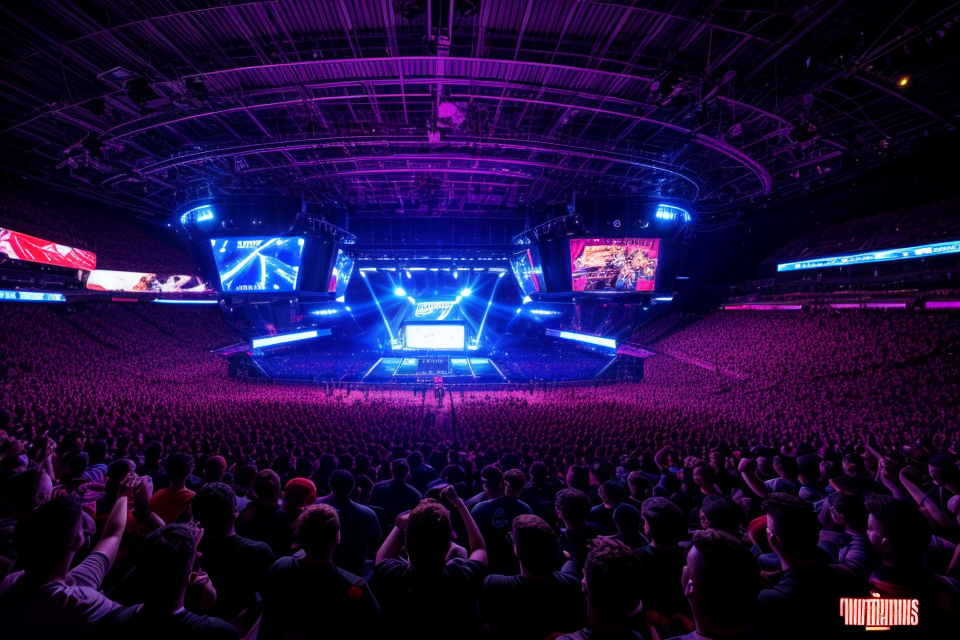USER: Please provide the first H2 heading for the article.
ASSURING YOU THE ULTIMATE EXPERIENCE
Esports have taken the world by storm, with millions of fans tuning in to watch their favorite games and players compete. But which esport reigns supreme? In this article, we will delve into the world of esports and uncover the #1 esport that has captured the hearts of gamers and spectators alike. Get ready for an exciting journey as we explore the top contenders and unveil the ultimate esport champion.
Esports has taken the world by storm, with millions of fans tuning in to watch their favorite games and players compete in virtual arenas. But with so many games and tournaments to choose from, which one can be considered the #1 esport? In this article, we’ll explore the most popular esports games and determine which one reigns supreme. Get ready for an in-depth look at the biggest and best in esports, as we unveil the ultimate showdown of the #1 esport.
Defining Esports: A Brief Overview
The Evolution of Esports
The realm of competitive video gaming, commonly referred to as esports, has experienced a remarkable transformation over the past few decades. Its humble beginnings can be traced back to the 1970s, when the first known video game competition took place in Stanford Artificial Intelligence Laboratory. Since then, esports has come a long way, with a rapidly growing fan base, expanding global presence, and an increasing number of professional players and teams.
The Evolution of Esports
- 1970s and 1980s: The early years of esports were characterized by a limited number of competitions held in small venues, predominantly focused on games like Spacewar!, Asteroids, and Missile Command.
- 1990s: With the rise of LAN (Local Area Network) parties and the internet, esports began to gain traction, leading to the organization of tournaments for games like Warcraft II, StarCraft, and Quake.
- 2000s: Esports entered a new era with the growth of online gaming, allowing for wider participation and the creation of professional leagues, such as the Cyberathlete Professional League (CPL) and the World Cyber Games (WCG).
- 2010s: The esports industry continued to grow, with increased sponsorship deals, larger prize pools, and the rise of streaming platforms like Twitch. The emergence of games like League of Legends, Dota 2, and Call of Duty further popularized esports.
- 2020s: The COVID-19 pandemic accelerated the growth of esports, with more events transitioning online and the increasing popularity of mobile esports. The industry’s global reach also expanded, with major tournaments like the Overwatch League and the League of Legends Championship Series attracting international attention.
Today, esports has cemented its position as a legitimate form of competitive entertainment, boasting a global audience of millions and attracting substantial investments from both the private and public sectors. The industry continues to evolve, with new technologies and game titles emerging, and it remains to be seen which game will ultimately be crowned the #1 esport.
Types of Esports Games
Esports has witnessed a tremendous surge in popularity over the past few years, with an increasing number of people participating in competitive video gaming. One of the primary reasons behind this growth is the diverse range of esports games available across multiple genres. In this section, we will explore the various types of esports games that have gained prominence in the esports ecosystem.
Esports games can be broadly categorized into several types, each with its unique set of characteristics and gameplay mechanics. These categories include:
- Real-Time Strategy (RTS) Games: RTS games are characterized by the player’s ability to control individual units and manage resources to achieve specific objectives. Examples of popular RTS games in esports include StarCraft II, Warcraft III, and Age of Empires.
- Multiplayer Online Battle Arena (MOBA) Games: MOBA games typically involve teams of players battling against each other in a virtual arena. Examples of popular MOBA games in esports include Dota 2 and League of Legends.
- First-Person Shooter (FPS) Games: FPS games involve players engaging in combat using weapons and other equipment. Popular FPS games in esports include Counter-Strike: Global Offensive, Call of Duty, and Overwatch.
- Fighting Games: Fighting games are characterized by one-on-one combat between players using various techniques and special moves. Popular fighting games in esports include Street Fighter, Tekken, and Mortal Kombat.
- Sports Games: Sports games in esports include simulations of real-world sports such as FIFA, NBA 2K, and Rocket League. These games often involve teams of players competing against each other in virtual sports tournaments.
- Card Games: Card games in esports include titles such as Hearthstone and Magic: The Gathering Arena, which involve players strategically using cards to defeat their opponents.
- Battle Royale Games: Battle royale games, such as Fortnite and PlayerUnknown’s Battlegrounds, involve players competing against each other in a virtual arena, with the last player or team standing being declared the winner.
Each of these categories offers a unique gaming experience, attracting different segments of the esports audience. As a result, esports games have evolved to cater to a wide range of interests and preferences, contributing to the growth and diversity of the esports ecosystem.
The Growing Popularity of Esports
Esports, short for electronic sports, refers to organized competitions involving video games. These competitions often have large prizes and audiences, and many people consider esports to be a legitimate sport.
The popularity of esports has been growing rapidly in recent years. In 2019, the global esports market was valued at over $1 billion, and it is projected to reach $1.8 billion by 2022. This growth can be attributed to a number of factors, including the increasing availability of high-speed internet, the rise of mobile gaming, and the growing popularity of live streaming platforms like Twitch.
Esports have also gained mainstream acceptance, with many traditional sports organizations and broadcasters taking notice. The NBA, NHL, and FIFA have all hosted esports tournaments, and ESPN has even launched its own esports coverage. This mainstream acceptance has helped to further legitimize esports as a sport, and has contributed to its growing popularity.
In addition to its growing mainstream acceptance, esports has also become increasingly popular among young people. A survey conducted by SuperData Research found that 60% of esports fans are under the age of 34, and that the majority of esports fans are male. This demographic skew is likely due to the fact that many popular esports games, such as League of Legends and Dota 2, are primarily played by and marketed to young men.
Overall, the growing popularity of esports is a testament to its potential as a legitimate sport and a form of entertainment. As the industry continues to grow and evolve, it will be interesting to see how it is received by mainstream audiences and whether it will eventually be considered a fully-fledged sport.
The Top Contenders for the #1 Esport Title
Game #1: Dota 2
Dota 2, developed by Valve Corporation, is a multiplayer online battle arena (MOBA) game that has been a staple in the esports scene since its release in 2013. It is a sequel to the popular Warcraft III mod, Defense of the Ancients (DotA), and has since become one of the most popular esports games in the world.
Dota 2 is known for its complexity and depth, with a steep learning curve that requires players to master a wide range of skills, from strategic decision-making to precise mechanics. The game features a roster of over 100 playable heroes, each with their own unique abilities and playstyles, making it a game of endless possibilities.
The competitive scene for Dota 2 is massive, with major tournaments offering millions of dollars in prize money. The game’s largest tournament, The International, has been known to award over $30 million in prize money, making it one of the largest esports events in the world.
Dota 2’s popularity is also reflected in its viewership numbers, with millions of people tuning in to watch the game’s major tournaments. This, combined with its large player base and strong community, makes Dota 2 a strong contender for the title of the #1 esport.
Game #2: League of Legends
League of Legends (LoL):
- Background:
- Released in 2009 by Riot Games.
- Free-to-play multiplayer online battle arena (MOBA) game.
- Over 100 million monthly active players.
- Gameplay:
- Two teams of five players compete to destroy the enemy team’s “Nexus,” a large structure located in the enemy team’s base.
- Players select “Champions” with unique abilities and strengths to fight against the enemy team.
- The game features a variety of game modes, including Summoner’s Rift, Twisted Treeline, and Howling Abyss.
- Esports Scene:
- LoL has one of the largest esports scenes, with a professional league (League of Legends Championship Series, LCS) and numerous international tournaments.
- Major tournaments include the League of Legends World Championship, Mid-Season Invitational, and All-Star Event.
- Prize pools for these tournaments often reach millions of dollars.
- Influence on Esports:
- LoL was one of the first games to popularize the concept of esports in the MOBA genre.
- The game’s competitive scene has spawned numerous rivalries, legendary moments, and famous players.
- LoL has influenced the development of other MOBA games and esports titles.
- The Road to the #1 Title:
- LoL’s diverse gameplay, competitive scene, and passionate fanbase make it a strong contender for the #1 esport title.
- Its influence on the esports industry and consistent success in tournaments make it a force to be reckoned with.
- However, its future in the esports landscape remains to be seen, as new games and genres continue to emerge.
Game #3: Counter-Strike: Global Offensive
Counter-Strike: Global Offensive (CS:GO) is a first-person shooter game that has been a staple in the esports scene since its release in 2012. The game is played by two teams, Terrorists and Counter-Terrorists, who compete against each other to complete objectives and eliminate the enemy team.
CS:GO has a large and dedicated fan base, with many professional players and teams competing in various leagues and tournaments around the world. The game’s popularity is due in part to its strategic gameplay, which requires teamwork and communication between players.
One of the most notable aspects of CS:GO is its competitive scene, which includes major tournaments such as the ELEAGUE Boston Major and the ESL One Cologne. These events attract some of the best players and teams from around the world, and the prize pools are often in the millions of dollars.
In addition to its competitive scene, CS:GO also has a thriving amateur and semi-professional scene, with many online leagues and tournaments catering to players of all skill levels. This makes it an accessible game for many players who want to compete at a high level without necessarily making a career out of it.
Overall, CS:GO is a game that is well-suited to the esports format, with its strategic gameplay and competitive nature. It remains one of the most popular games in the esports scene, and it will be interesting to see how it fares in the ultimate showdown for the #1 esport title.
Game #4: Fortnite
Fortnite: A Brief Overview
Fortnite, developed by Epic Games, has been a force to be reckoned with in the esports scene since its inception in 2017. Known for its unique blend of battle royale gameplay and building mechanics, Fortnite has amassed a massive following and has become a staple in the esports industry.
The Rise of Fortnite Esports
In 2018, Fortnite made its official debut in the esports scene with the “Fortnite World Cup.” This marked a significant turning point for the game, as it demonstrated Epic Games’ commitment to supporting competitive play and fostering a thriving esports community.
Fortnite’s Esports Ecosystem
Fortnite’s esports ecosystem is characterized by its diverse array of competitions, including weekly online tournaments, monthly championships, and annual events such as the “Fortnite World Cup.” These events attract a massive audience, with millions of viewers tuning in to watch top players battle it out for supremacy.
The Impact of Fortnite on Esports
Fortnite’s impact on the esports landscape cannot be overstated. The game’s massive popularity has led to the creation of numerous professional teams, players, and content creators, all dedicated to the pursuit of victory. Furthermore, Fortnite’s accessibility and free-to-play model have helped democratize esports, allowing anyone with an internet connection to participate in competitions and potentially rise to the top.
The Future of Fortnite Esports
As Fortnite continues to evolve, so too does its esports scene. With new game modes, collaborations with popular franchises, and ongoing updates, the game remains fresh and engaging for both players and spectators. As a result, Fortnite is poised to maintain its position as a dominant force in the esports world for years to come.
Game #5: Call of Duty
Call of Duty is a first-person shooter game that has been a fan favorite for many years. It has a massive following in the esports community and has produced some of the most thrilling moments in gaming history. With its fast-paced gameplay and intense competition, Call of Duty has become a staple in the esports scene.
One of the reasons why Call of Duty is so popular in esports is due to its accessibility. The game is easy to learn, but difficult to master, making it a great entry point for new players. Additionally, the game’s developers regularly release new maps and game modes, keeping the game fresh and exciting for players.
Another reason why Call of Duty is a top contender for the #1 esport title is due to its competitive nature. The game’s developers have created a robust esports ecosystem, complete with professional leagues, tournaments, and prize pools. Some of the biggest esports events in the world feature Call of Duty, including the Call of Duty World League, which has a massive following and offers millions of dollars in prizes.
The game’s competitive nature has also led to the development of highly skilled players who have become household names in the esports community. Players like Seth “Scump” Abner and Michael “Dog” Cecchini have become legends in the game, consistently performing at the highest level and earning millions of dollars in prize money.
Call of Duty’s popularity in esports has also led to the development of a thriving streaming and content creation scene. Many popular streamers and content creators focus on Call of Duty, providing fans with hours of entertainment and analysis. This has helped to further increase the game’s popularity and has made it a must-watch for many esports fans.
In conclusion, Call of Duty is a top contender for the #1 esport title due to its accessibility, competitive nature, and the development of a thriving esports ecosystem. With its massive following and dedication to the esports scene, it is clear that Call of Duty will continue to be a force to be reckoned with in the world of esports.
Factors Contributing to the Success of the #1 Esport
Player Skill and Strategy
The success of the #1 Esport can be attributed to several factors, one of which is the role of player skill and strategy. These two elements play a crucial role in determining the outcome of a match and the overall success of a team or player.
Player Skill
Player skill refers to the individual talents and abilities of each player in the game. This includes physical attributes such as reaction time, hand-eye coordination, and fine motor skills, as well as mental attributes such as decision-making, strategic thinking, and adaptability.
Some of the most important player skills in the #1 Esport include:
- Aim: The ability to accurately aim and shoot at enemies or targets. This skill is critical in first-person shooter games and can make the difference between victory and defeat.
- Movement: The ability to move quickly and efficiently around the map. This skill is essential in games that require players to navigate complex environments and avoid enemy fire.
- Communication: The ability to communicate effectively with teammates and coordinate actions. This skill is crucial in team-based games, as it allows players to work together towards a common goal.
Strategy
Strategy refers to the overall plan and approach that a player or team takes in order to achieve their goals. This can include things like choosing the right hero or character, building the right items, and coordinating with teammates to take down objectives.
Some of the most important strategies in the #1 Esport include:
- Team Composition: Choosing the right combination of heroes or characters to work together as a team. This can include things like choosing a mix of damage dealers, healers, and support characters.
- Map Control: Controlling key areas of the map and denying access to them for the enemy team. This can include things like capturing objectives, defending key locations, and setting up ambushes.
- Economy Management: Managing resources and building the right items at the right time. This can include things like balancing the cost of offense and defense, and making strategic decisions about when to push and when to retreat.
Overall, player skill and strategy are two of the most important factors in determining the success of a player or team in the #1 Esport. By mastering these elements, players can gain a significant advantage over their opponents and climb the ranks of the leaderboard.
Spectator Engagement
The success of any esport relies heavily on the level of engagement from its audience. The #1 esport has been able to achieve this by offering an exciting and immersive experience for spectators. Here are some key factors that contribute to the high level of spectator engagement in the #1 esport:
- High-quality production: The #1 esport invests heavily in producing high-quality streams and broadcasts, with top-notch production values and professional commentary. This creates an immersive experience for viewers, making them feel like they are part of the action.
- Interactive features: The #1 esport offers a range of interactive features, such as live polls, in-game rewards, and virtual gifts, that allow viewers to engage with the game and the players in real-time. This creates a sense of community and fosters a deeper connection between the players and their fans.
- Competitive balance: The #1 esport maintains a delicate balance between the competitive and casual elements of the game, ensuring that both types of players can enjoy the game at their own level. This creates a diverse and inclusive community of players and fans, which helps to drive engagement and growth.
- Strategic depth: The #1 esport is a game of strategy, with a wide range of tactics and strategies that players can employ to gain an advantage over their opponents. This creates a sense of excitement and unpredictability, as viewers never know what new strategy a player might try next.
- Accessibility: The #1 esport is easy to pick up and play, with a simple set of rules and a low barrier to entry. This makes it accessible to a wide range of players, from casual gamers to hardcore competitors, and helps to drive engagement and growth.
Overall, the #1 esport has been able to achieve high levels of spectator engagement by offering an immersive and interactive experience for viewers, while also maintaining a delicate balance between competitive and casual play. This has helped to drive growth and success for the game, making it the #1 esport in the world.
Sponsorship and Prize Money
The Role of Sponsorship in Esports
In the world of esports, sponsorship plays a crucial role in the growth and development of the industry. Sponsorship deals between esports organizations and brands not only provide financial support but also help in creating brand awareness and expanding the reach of the sport. With the increasing popularity of esports, more and more brands are investing in sponsorship deals, making it a significant factor in the success of the #1 esport.
The Impact of Prize Money on Esports Competitions
Prize money is another important factor that contributes to the success of the #1 esport. Esports competitions offer substantial cash prizes that attract top talent from around the world. The lure of big money has made esports competitions highly competitive, with players and teams vying for the top spots. The prize money also serves as an incentive for the growth and development of the sport, as more and more people are motivated to participate in esports competitions to win big.
The Future of Sponsorship and Prize Money in Esports
As the popularity of esports continues to grow, the role of sponsorship and prize money in the industry is only set to increase. With more brands investing in esports, the industry is expected to see a rise in sponsorship deals, leading to increased brand awareness and expansion of the sport. Additionally, with the increasing prize money on offer, esports competitions are set to become even more competitive, attracting even more top talent and driving the growth of the #1 esport.
Esports Infrastructure and Organizations
The success of the #1 esport can be attributed to the strong esports infrastructure and organizations that support it. These organizations play a crucial role in shaping the esports landscape by providing a framework for competition, promoting the growth of the industry, and fostering the development of professional players. In this section, we will delve into the key aspects of esports infrastructure and organizations that contribute to the prominence of the #1 esport.
Game Design and Balancing
One of the essential factors that contribute to the success of the #1 esport is the game design and balancing. Esports games must be designed with competitive play in mind, ensuring that the game mechanics are balanced and provide a fair and exciting experience for players. The game’s developers must work closely with the esports community to gather feedback and make necessary adjustments to maintain the game’s competitive integrity. This approach ensures that the game remains engaging and entertaining for both casual and professional players, which is crucial for the growth and sustainability of the esport.
Esports Organizations and Teams
Esports organizations and teams play a significant role in the success of the #1 esport by providing a structured environment for players to develop their skills, collaborate with other talented individuals, and compete at the highest level. These organizations invest in infrastructure, training facilities, and coaching staff to help their teams perform at their best. Additionally, they provide financial support to players, which allows them to focus on their craft without the burden of financial worries. Esports organizations also serve as a gateway for aspiring players to enter the professional scene, as they often scout and recruit talented individuals from the lower tiers of competition.
Sponsorship and Investment
Sponsorship and investment from companies and investors are vital for the growth and development of the #1 esport. Esports organizations rely on sponsorship deals with companies to fund their operations and provide financial support to players. In addition, investors play a crucial role in funding the growth of the industry, enabling the development of new technologies, infrastructure, and content. Sponsorship and investment not only provide financial stability but also help to legitimize the esport, attracting more attention from mainstream audiences and increasing its appeal to potential players and fans.
Media Coverage and Broadcasting
Media coverage and broadcasting are essential components of the esports infrastructure, as they play a crucial role in bringing the #1 esport to a wider audience. Media outlets and broadcasting companies invest in high-quality production and commentary to provide an engaging viewing experience for fans. They also cover the latest news, updates, and developments in the esport, ensuring that fans stay informed and connected to the scene. Additionally, media coverage helps to build the reputation of the #1 esport, showcasing its competitive nature and entertainment value to potential fans and investors.
In conclusion, the success of the #1 esport is heavily influenced by the robust esports infrastructure and organizations that support it. From game design and balancing to sponsorship and investment, each aspect plays a crucial role in shaping the esport’s landscape and ensuring its growth and sustainability.
The Future of the #1 Esport
The future of the #1 esport is shining bright with a range of exciting developments and opportunities on the horizon. Here are some key trends and factors that are expected to shape the future of this dynamic and fast-growing industry:
Expansion into New Markets
One of the key trends in the future of the #1 esport is its expansion into new markets. With the increasing popularity of esports worldwide, the #1 esport is poised to continue its global conquest, with a focus on tapping into new and emerging markets in Asia, Europe, and other regions. This expansion is expected to drive growth and create new opportunities for both players and industry stakeholders.
Increased Investment and Sponsorship
Another important trend in the future of the #1 esport is the expected increase in investment and sponsorship. As the popularity and cultural impact of esports continue to grow, more brands and investors are expected to jump on board, fueling the growth of the industry and driving innovation in areas such as technology, content creation, and marketing. This increased investment is also likely to lead to higher salaries and better working conditions for professional players, further boosting the appeal of the #1 esport as a career choice.
The Rise of Esports as a Spectator Sport
The future of the #1 esport also promises to see the rise of esports as a spectator sport, with more events and competitions being held in stadiums and arenas around the world. This trend is expected to drive further growth and increase the visibility and mainstream acceptance of esports, as well as create new revenue streams for the industry through ticket sales, merchandise, and broadcasting rights.
The Impact of Emerging Technologies
Finally, the future of the #1 esport is also expected to be shaped by the impact of emerging technologies such as virtual reality (VR) and augmented reality (AR). These technologies have the potential to revolutionize the way esports are experienced and consumed, creating new opportunities for immersive and interactive gameplay and opening up new avenues for content creation and monetization.
Overall, the future of the #1 esport looks bright, with a range of exciting developments and opportunities on the horizon. As the industry continues to evolve and mature, it is poised to become an even more integral part of the global sports and entertainment landscape.
Expansion into New Markets
Embrace of Globalization
One key factor in the rise of the #1 esport has been its ability to embrace globalization. By recognizing the potential of new markets, the industry has expanded beyond its traditional boundaries, tapping into a broader audience and generating greater revenue. This expansion has been driven by several interrelated factors:
Growing Popularity in Emerging Markets
The popularity of esports has grown rapidly in emerging markets, particularly in Asia and parts of Europe. These regions have embraced esports as a form of entertainment, and have provided a significant boost to the industry’s growth. In response, the #1 esport has sought to capitalize on this trend by increasing its presence in these markets, hosting tournaments and events that cater to local audiences.
Investment in Infrastructure
In order to support its expansion into new markets, the #1 esport has invested heavily in infrastructure. This has included the development of new venues, the creation of local esports leagues, and the establishment of training facilities. By investing in these resources, the industry has been able to create a more robust ecosystem that supports the growth of esports in these regions.
Collaboration with Local Organizations
In order to further facilitate its expansion into new markets, the #1 esport has sought to collaborate with local organizations. This has included partnerships with sports teams, broadcasters, and other entities that have helped to promote the industry and increase its visibility. By working with these organizations, the #1 esport has been able to establish a foothold in these markets and build a strong foundation for future growth.
Adaptation to Local Culture
Finally, the #1 esport has sought to adapt to local culture in order to succeed in new markets. This has involved a deep understanding of the preferences and values of local audiences, as well as a willingness to modify its products and services to better meet their needs. By embracing local culture, the #1 esport has been able to establish a strong connection with these audiences and build a loyal fan base.
Innovations in Technology and Game Design
The Role of Technology in the Evolution of Esports
- The increasing advancements in technology have significantly impacted the esports industry.
- The development of better hardware and software has allowed for more immersive gaming experiences, enabling gamers to compete at higher levels.
- The introduction of cloud gaming, virtual reality, and augmented reality technologies have transformed the way games are played and viewed, creating new opportunities for players and spectators alike.
The Impact of Game Design on Esports Popularity
- Game design plays a crucial role in the success of esports, as it directly affects the gameplay and competitive balance.
- The popularity of esports titles is often driven by their competitive aspects, such as skill ceilings, balanced gameplay, and diverse strategies.
- The development of esports-oriented games, like Dota 2 and League of Legends, has led to the creation of massive esports ecosystems with large prize pools and dedicated fan bases.
The Influence of Esports on Game Design
- The rise of esports has also influenced the design of new games, as developers seek to create titles that cater to the growing esports market.
- Games like Overwatch and Rainbow Six Siege have been designed with competitive play in mind, incorporating features like dedicated servers, in-game observation tools, and tournament support.
- This collaboration between esports and game design has led to a virtuous cycle of growth, where popular esports titles drive further innovation in game design, which in turn fosters even more competitive gameplay.
The #1 Esport: [Game Name]
[Game Name]: A Thriving Esport
- Wide Player Base
- Global Popularity: With millions of active players worldwide, [Game Name] has established itself as a beloved game across different cultures and regions.
- Diverse Player Demographics: The game attracts a wide range of players, from casual enthusiasts to professional athletes, making it a versatile and dynamic esport.
- Engaging Gameplay
- Rich Storyline: [Game Name] offers a captivating storyline that keeps players engaged and motivated to progress through the game.
- Wide Range of Game Modes: The game offers various game modes, catering to different player preferences and skill levels, ensuring that there’s always something for everyone.
- Competitive Scene
- Established Tournaments: [Game Name] has a robust esports scene, with numerous tournaments and events held both locally and internationally, attracting top talent from around the world.
- Strong Support from Developers: The game’s developers actively support the esports scene, providing funding and resources for tournaments and other esports-related initiatives.
- Technological Advancements
- Improved Graphics and Performance: [Game Name] has seen significant improvements in graphics and performance over the years, enhancing the overall gaming experience for players.
- Integration of Esports Features: The game has been designed with esports in mind, featuring built-in features such as replays, spectator modes, and tournament support, making it well-suited for competitive play.
- Growing Investment and Sponsorship
- Increased Investment: As the popularity of [Game Name] esports continues to grow, more investors are flocking to the scene, providing the necessary funds for tournaments, teams, and players.
- Growing Sponsorship: Brands and companies are increasingly recognizing the value of [Game Name] esports as a marketing platform, leading to a surge in sponsorship deals for teams and players.
- Innovative Marketing and Promotion
- Social Media Presence: [Game Name] has a strong social media presence, with numerous influencers and content creators promoting the game and the esports scene.
- In-Game Promotions: The game itself features in-game promotions and events that encourage players to participate in esports, further fueling the growth of the scene.
These factors contribute to the success of [Game Name] as the #1 esport, showcasing its strengths as a game that appeals to a wide audience, offers engaging gameplay, and has a thriving competitive scene.
Why [Game Name] Prevails as the Ultimate Esport
Competitive Balance
One of the primary reasons why [Game Name] has emerged as the ultimate esport is its competitive balance. The game’s developers have struck a delicate equilibrium between various factors, such as character abilities, weaponry, and maps, resulting in a dynamic and engaging competitive environment. This balance allows both casual and professional players to enjoy the game, as the skill gap between novice and expert players is not excessively wide. As a result, the esport has managed to attract a diverse and dedicated fan base, contributing to its overall success.
Rich Game Mechanics
Another reason for [Game Name]’s ascendance as the preeminent esport is its intricate game mechanics. The game offers a wide array of strategic options and tactical decisions, which leads to high replayability and deep strategic thinking. These mechanics, combined with the game’s competitive balance, encourage players to continuously refine their skills and adapt to new strategies, ensuring that the esport remains fresh and engaging for both players and spectators.
Strong Developer Support
[Game Name]’s developers have demonstrated a strong commitment to supporting the esport’s growth and development. They have invested in the creation of robust esports infrastructure, including dedicated tournaments, professional leagues, and organized events. Additionally, the developers regularly update the game, introducing new content and balance changes to keep the esport vibrant and thriving. This consistent support has helped to solidify [Game Name]’s position as the #1 esport, as it demonstrates the developer’s dedication to the game’s competitive future.
Global Appeal
Finally, [Game Name]’s global appeal has played a significant role in its ascendance as the ultimate esport. The game has garnered a massive and diverse international fan base, with players and fans hailing from various regions and cultures. This global appeal has contributed to the esport’s popularity, as it has allowed for the creation of numerous local and regional tournaments and events, further enriching the game’s competitive landscape. Moreover, the game’s developers have shown a keen understanding of regional differences, ensuring that the game remains culturally relevant and engaging for fans worldwide.
The Impact of [Game Name] on the Esports Industry
The Esports industry has witnessed tremendous growth over the past few years, with numerous games contributing to this expansion. Among these games, [Game Name] has emerged as a standout, leaving a lasting impact on the industry. In this section, we will delve into the factors that have made [Game Name] a trailblazer in the Esports landscape.
- Game Design and Mechanics: One of the primary reasons behind [Game Name]’s success is its well-designed gameplay mechanics. The game offers a unique blend of strategic depth and accessible gameplay, making it appealing to both casual and professional players. The developers’ commitment to balancing and regular updates has ensured that the game remains competitive and engaging for the esports community.
- Community and Fan Base: [Game Name] has fostered a passionate and dedicated community, with fans from all walks of life. This community has been instrumental in promoting the game and driving interest in esports tournaments and events. The game’s popularity has led to an influx of investment, sponsorships, and media coverage, further solidifying its position as a top esport.
- Esports Ecosystem: [Game Name] has built a strong esports ecosystem, with various tournaments and leagues catering to different skill levels. This ecosystem has provided opportunities for aspiring players to hone their skills and compete at the highest level. The game’s developers and organizers have worked together to create a structured and sustainable environment for esports competition, contributing to the growth of the game and the industry as a whole.
- Innovation and Technological Advancements: [Game Name] has embraced technological advancements, leveraging them to enhance the overall esports experience. The integration of live streaming, virtual reality, and other cutting-edge technologies has brought fans closer to the action and provided players with advanced training tools. This innovative approach has helped [Game Name] stay ahead of the curve and maintain its status as a leading esport.
- Global Appeal: [Game Name] has transcended cultural and geographical barriers, finding appeal among players and fans worldwide. This global reach has contributed to the game’s success in the esports landscape, as it has attracted a diverse range of talent and created a thriving international competitive scene.
In conclusion, [Game Name] has left an indelible mark on the Esports industry due to its game design, community support, esports ecosystem, technological advancements, and global appeal. These factors have combined to make [Game Name] the undisputed leader in the world of esports, shaping the future of competitive gaming and inspiring other games to follow in its footsteps.
Final Thoughts and the Future of Esports
The Influence of Technology
Technology has been a significant driving force behind the growth and success of esports. Advances in video game technology, streaming platforms, and virtual reality have provided a more immersive and engaging experience for players and spectators alike. As technology continues to evolve, it is likely that esports will continue to expand and reach new audiences.
The Rise of Esports Betting and Sponsorships
Esports betting and sponsorships have also played a crucial role in the success of the #1 esport. With the growing popularity of esports, more and more people are becoming interested in betting on their favorite teams and players. This has led to a surge in the number of esports betting sites and platforms, as well as increased sponsorship deals between esports organizations and major brands.
The Importance of Community and Fan Engagement
Finally, the success of the #1 esport can also be attributed to the strong sense of community and fan engagement within the esports industry. Esports organizations have worked hard to build strong relationships with their fans, creating a sense of belonging and loyalty among their followers. This has led to a highly engaged and passionate fan base, which has helped to drive the growth and success of esports.
Overall, the success of the #1 esport can be attributed to a combination of factors, including the influence of technology, the rise of esports betting and sponsorships, and the importance of community and fan engagement. As the industry continues to evolve and grow, it will be interesting to see how these factors continue to shape the future of esports.
FAQs
1. What is the #1 esport?
The #1 esport is a title given to the most popular and widely-watched esport game in the world. There are many factors that contribute to an esport game becoming the #1, such as its player base, viewership, tournaments, and prize pools. As of now, the #1 esport is a matter of debate and can vary depending on who you ask. Some people argue that it is Dota 2, while others believe it to be League of Legends, and still others believe it to be a different game altogether.
2. What makes an esport game the #1?
There are many factors that contribute to an esport game becoming the #1. These include the size of its player base, the level of competition, the quality of the tournaments and events, the viewership numbers, and the prize pools. The #1 esport game is typically one that has a large and dedicated player base, exciting and unpredictable competitions, and a strong presence in the esports community.
3. Why is the #1 esport important?
The #1 esport is important because it is the game that sets the standard for all other esports. It is the game that attracts the most attention, the most viewers, and the most players. The #1 esport is also the game that generates the most revenue and has the biggest prize pools. Being the #1 esport game means that it is the game that everyone wants to play and watch, and it has a major impact on the entire esports industry.
4. How does the #1 esport change over time?
The #1 esport can change over time as new games are released, as player preferences shift, and as the esports industry evolves. A game that was once the #1 esport may no longer hold that title years later, as new games come out and capture the attention of players and viewers. The #1 esport is not a static title, and it is always subject to change as the esports landscape shifts.
5. Can a new game become the #1 esport?
Yes, a new game can become the #1 esport if it has the right combination of factors, such as a large player base, exciting competitions, and a strong presence in the esports community. New games are constantly being released, and some of them have the potential to become the #1 esport if they can capture the attention of players and viewers. However, it is important to note that becoming the #1 esport is a difficult task, and it requires a lot of hard work, dedication, and innovation.









